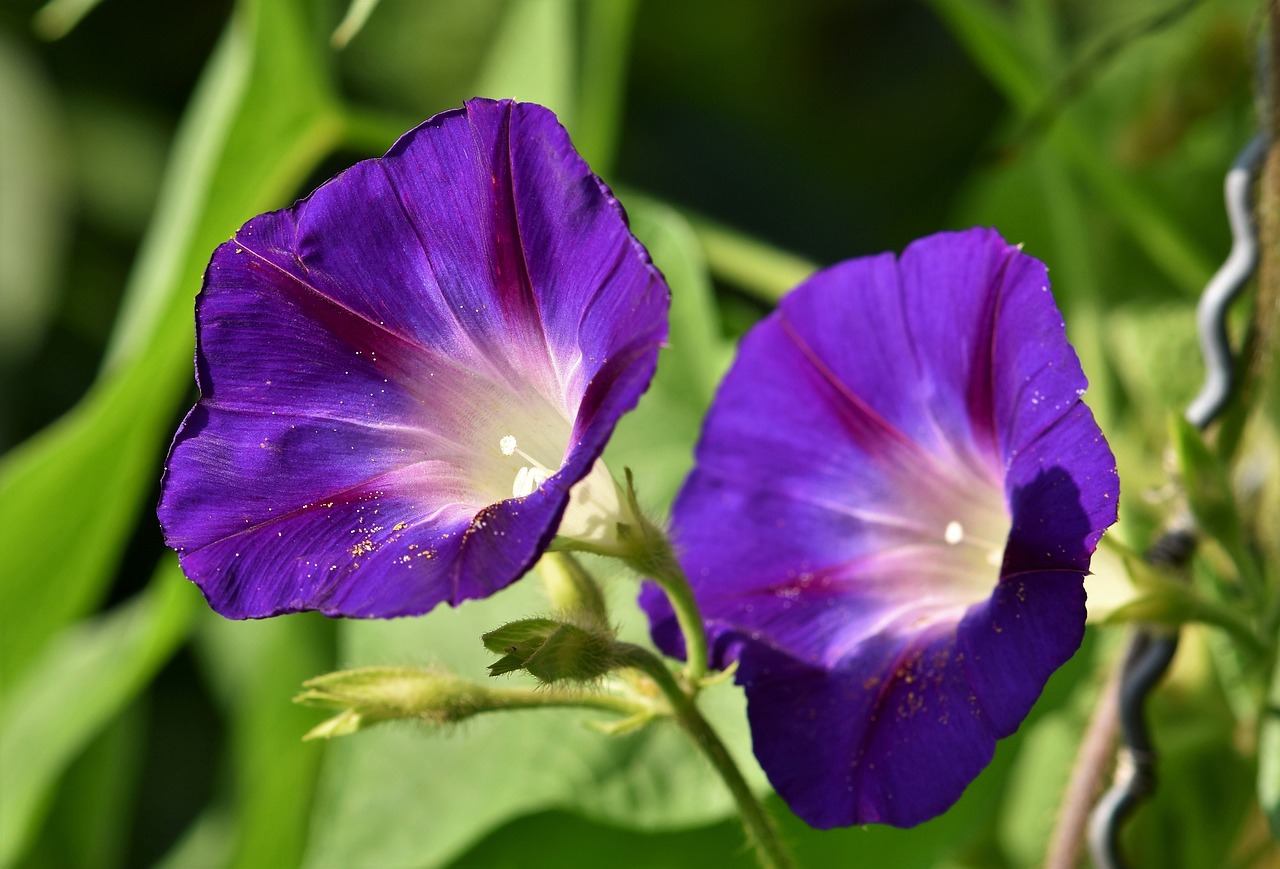Morning Glory
Overview
The Morning Glory (Ipomoea purpurea) is a vibrant plant from the Convolvulaceae family, often grown for its striking heart-shaped leaves and radiant flowers, which vary from purple to white. Thriving in well-drained soils under full sunlight, this plant can be both an ornamental beauty and, in certain species, a culinary delight, though some forms are considered noxious weeds.

Characteristics
Known for its vibrant, trumpet-shaped flowers and heart-shaped leaves, thriving in full sunlight and requiring a supporting structure for growth.
Region
The Morning Glory plant is commonly found and grown in North America, as well as many other temperate and tropical world regions.
Natural Habitat
The Morning Glory plant is commonly found in fields, along roadsides, and in disturbed soils.
Cultivation
Thrives in full sunlight, requires consistently moist, well-drained soil.
Uses and Benefits
Morning Glories, specifically Ipomoea aquatica, not only embellish gardens but also hold a significant place in culinary traditions, primarily in East and Southeast Asia where they are enjoyed as tasty green vegetables4. Below are the key uses and benefits of the Morning Glory plant:
- Culinary Uses: The stems and leaves of Ipomoea aquatica are commonly used in a variety of dishes, providing a crisp texture and mild flavor.
- Ornamental Value: Varieties like Ipomoea purpurea are cultivated for their vibrant and attractive flowers, which can enhance the aesthetic appeal of any garden space1.
- Nutritional Benefits: Rich in vitamins and minerals, these plants contribute beneficial nutrients when included in diets.
- Soil Improvement: As a fast-growing vine, Morning Glory can help in covering bare soils quickly, potentially reducing weed growth and soil erosion.
Despite these benefits, it is important to note that the plant can be considered invasive in certain regions and might require specific permits for cultivation and use4.

Cultivation Tips
To successfully cultivate Morning Glory (Ipomoea purpurea), consider these practical tips:
- Start by planting seeds indoors approximately 6-8 weeks before your area’s last expected frost. This early start helps establish robust seedlings ready for warmer weather.
- Improve seed germination by gently notching each seed’s coat with a knife. This small effort can significantly enhance the germination rate.
- Choose a location that offers full sunlight. Morning Glory thrives in bright, direct light, which is crucial for optimal growth and flower production.
- Ensure the soil is well-drained yet consistently moist. While the plant is somewhat tolerant, soggy conditions can hinder its growth.
- Provide a sturdy support structure, such as a trellis or fence, for the vines to climb. This not only supports healthy growth but also showcases the plant’s natural beauty.
Following these guidelines will help you enjoy the lush foliage and vibrant blooms of Morning Glory throughout the growing season.
Companion Planting
When cultivating Ipomoea purpurea, consider plants that can share its robust support structures. Vegetable crops, such as beans or tomatoes, are beneficial companions due to their similar structural needs. Avoid planting nearby invasive or excessively competitive species that could hinder growth. Cohabitation with other vines should be managed to prevent overcrowding and ensure all plants receive ample sunlight5.
Seasonal Considerations
The Morning Glory plant, with its beautiful blooms, is best grown in certain seasonal conditions to thrive:
- The optimal planting time is spring, soon after the last frost, when the soil has warmed up.
- It flourishes in the summer, requiring full sunlight to produce its vibrant flowers.
- Maintenance should focus on adequate watering and support structures during these warmer months.
Gardeners should be mindful that this plant tends to retreat as temperatures begin to drop in late autumn, making early growth periods crucial for a hearty display5.

Issues and Troubleshooting
The Morning Glory (Ipomoea purpurea) commonly experiences several issues when cultivated. Notably, overwatering can lead to root rot, while under-watering might stress the plant, inhibiting growth and flowering. An imbalance in sunlight exposure—either too much or too little—can negatively impact the plant’s health, often manifesting in weak foliage or reduced blooming.
A prevalent problem is pest infestation, particularly from aphids and spider mites. These pests can weaken the plant by sucking sap, leading to distorted and discolored leaves. Treating these with appropriate organic insecticides or introducing natural predators like ladybugs can be effective.
Moreover, the Morning Glory is susceptible to fungal diseases such as powdery mildew and rust, which thrive in humid conditions. Ensuring good air circulation and reducing leaf wetness can help manage these fungal issues. Regular monitoring and adopting a proactive treatment approach are key to maintaining a healthy Morning Glory vine1.
History and Folklore
The Morning Glory plant, known scientifically as Ipomoea purpurea, carries a rich tapestry of history and lore. Revered in various cultures for its vibrant blossoms that greet the sun each morning, it symbolizes renewal and the fleeting nature of life. In Japanese culture, Morning Glory, or “Asagao,” was traditionally associated with the samurai to express the ephemeral quality of their lives. Additionally, in Victorian flower language, it represented love and affection, albeit with a transient quality. This deep-rooted symbolism makes the Morning Glory a captivating subject in both historical and cultural studies, reverberating through its role in art and folklore.
References
1. Morning glory | Description & Species | Britannica, https://www.britannica.com/plant/morning-glory-plant
2. Morning Glory | Herbaceous Plant Finder | Comprehensive Landscape Plant, https://www.depts.ttu.edu/plantresources/Pages/directories/landscape-info-sheets/herbaceous-info/Ipomoea_purpurea.php
3. Family: Convolvulaceae — morning glory family – Go Botany, https://gobotany.nativeplanttrust.org/family/convolvulaceae/
4. Morning glory – Wikipedia, https://en.wikipedia.org/wiki/Morning_glory
5. Ipomoea purpurea – Plant Finder – Missouri Botanical Garden, https://www.missouribotanicalgarden.org/PlantFinder/PlantFinderDetails.aspx?kempercode=b754
Image Credit: Ralphs_Fotos
Image Credit: MabelAmber
Image Credit: Ray_Shrewsberry
Nicolas Duval
Nicolas is a passionate advocate for nature and the art of wildcrafting. His dedication shines through in Wildcraftia, a website he meticulously crafted to serve as a haven for nature enthusiasts worldwide. Driven by a deep appreciation for nature’s connection to humanity, Nicolas embarked on his journey in 2011 with SmokableHerbs, a platform showcasing his love for nature’s bounty. Building upon this foundation, he established Smokably, a thriving online store offering premium herbs and blends to a global audience.
